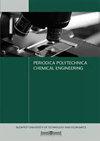沉淀法测定城市垃圾填埋场附近地下水污染的碳和氧同位素
IF 1.8
4区 工程技术
Q3 ENGINEERING, CHEMICAL
引用次数: 1
摘要
本文强调了同位素研究作为一种检测垃圾渗滤液污染地下水的独特工具的重要性。这项研究的目的是提出一种基于稳定同位素分析的额外和有用的检测地下水污染的方法。所提出的方法依赖于对测量的δ13CDIC和δ18O水平的解释(在制备水样期间沉淀碳酸盐中)。根据该方法,确定了两个不同同位素组成的地下水带:第一个带为天然地下水,δ13CDIC含量低(−20.6 ~−12.4‰),δ18O含量高(−13.6 ~−8.0‰);第二个带为富δ13CDIC含量高(−10.9 ~ + 3.6‰),δ18O含量高(−9.8 ~−7.1‰)的渗滤液污染地下水。仅测量氧的同位素组成不足以划定污染区,因为自然水平与地下水渗滤液污染的水平部分重叠。垃圾渗滤液污染水中δ13CDIC和δ18O的测定可为城市垃圾填埋场附近地下水污染检测提供有效工具,并有助于减少常规参数分析所需的采样数量。这种经过验证的方法可能为检测地下水污染提供一种易于使用的解决方案。本文章由计算机程序翻译,如有差异,请以英文原文为准。
Precipitation Method for Determination of Carbon and Oxygen Isotopes to Detect Groundwater Contamination Near a Municipal Landfill
The paper emphasizes the importance of isotope studies as a unique tool for detecting groundwater contamination with the landfill leachate. The aim of the study was to present an additional and useful method for detecting groundwater contamination, based on stable isotope analysis. The proposed method relies on the interpretation of measured δ13CDIC and δ18O levels (in precipitated carbonates during preparation of a water sample). According to this method, two zones with different isotope composition of groundwater were identified: the first zone with natural groundwater and with low δ13CDIC levels (from −20.6 to −12.4‰) and high δ18O levels (from −13.6 to −8.0‰), and the second zone with leachate-contaminated groundwater rich in δ13CDIC (from −10.9 to + 3.6‰) and high level of δ18O (from −9.8 to −7.1‰). Measuring the isotopic composition of oxygen alone, is insufficient to delimit the contaminated zone due a partial overlap of natural levels with those of the contaminated with groundwater leachates. Determination of δ13CDIC and δ18O in the landfill leachate-contaminated water can provide an effective tool to detect groundwater contamination near municipal landfills, and it can help to minimize the number of samples collected for the analysis of conventional parameters. This proven method may offer an easy-to-use solution for detecting groundwater contamination.
求助全文
通过发布文献求助,成功后即可免费获取论文全文。
去求助
来源期刊

Periodica Polytechnica Chemical Engineering
ENGINEERING, CHEMICAL-
CiteScore
3.10
自引率
7.70%
发文量
44
审稿时长
>12 weeks
期刊介绍:
The main scope of the journal is to publish original research articles in the wide field of chemical engineering including environmental and bioengineering.
 求助内容:
求助内容: 应助结果提醒方式:
应助结果提醒方式:


